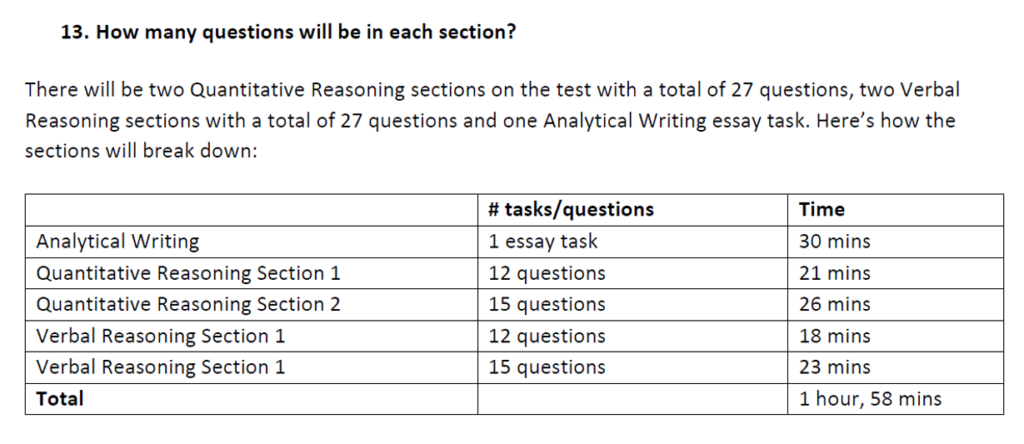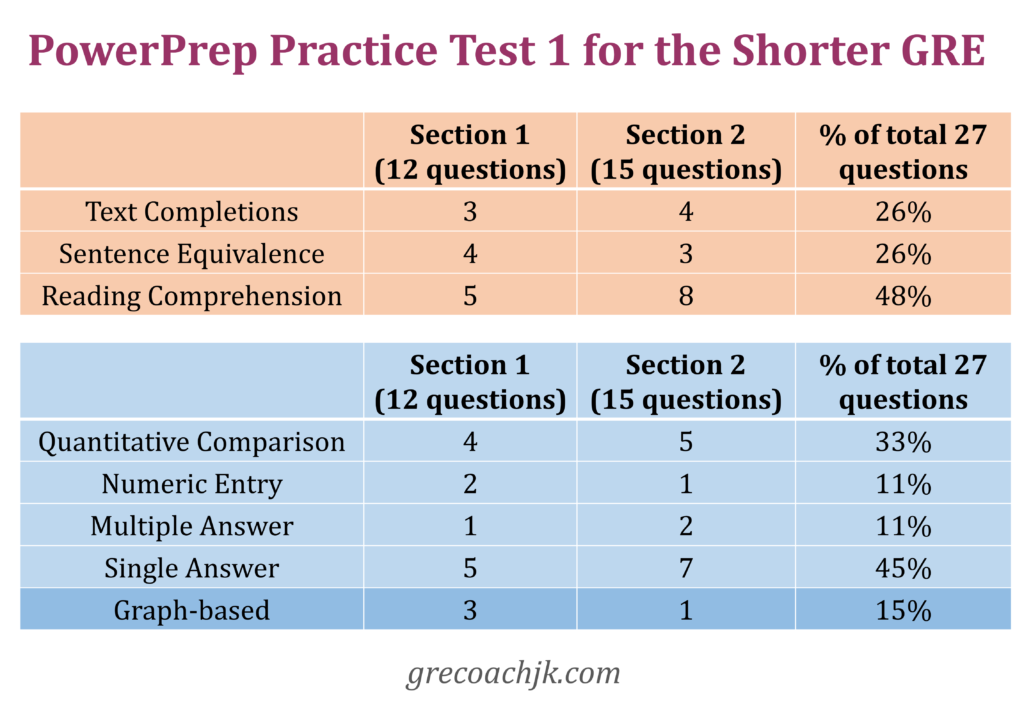Table of Contents
- An overview of the changes
- How to practice for the shorter GRE?
- Takeaways about the shorter GRE format from the new PowerPrep1 (for the Shorter GRE)
An overview of the changes
Before September 22, 2023, the GRE used to be a 3 hours 45 minutes long test. From this date, it became only about half as long (its exact duration now is 1 hour 58 minutes).
The study material for the new GRE format is the same as that for the earlier (longer) GRE. You can safely continue to use the existing editions of the GRE Official books. For more context on this, refer to my analysis in the second-half of this article of the Power Prep 1 test for the shorter format.
The changes made in the shorter GRE wrt the earlier (longer) GRE format
* The ‘Analyse an Argument’ task was chopped off. Now, there is only one essay to write – ‘Analyse an Issue.’
* The earlier version had two scored sections of 20 questions each (so, the total number of scored questions = 20 + 20 = 40) for both quant and verbal. The shorter version still has two scored sections for both quant and verbal. But now, the two sections do not have the same length.
The section-wise structure is the same for both quant and verbal and is as follows:
- Section 1 – which will be of medium difficulty level – will have only 12 questions.
- Section 2 – whose difficulty level will be easy, medium or hard, depending on performance in Section 1 – will have 15 questions.
So, the total number of scored questions in a test now is 12 + 15 = 27, for quant as well as for verbal.

* The earlier GRE used to have an unscored experimental section, which could be either quant or verbal and would have the same structure as the scored sections (’20 questions to be done in 35 minutes’ if it was a quant section, and ’20 questions to be done in 30 minutes’ if it was a verbal section). The shorter GRE does not have this section.
* As the complete test itself is now less than 2 hours, the scheduled break that test-takers were allowed to take around the 2-hour mark in the longer version is not offered now.
* The score reports are available faster, in just 8-10 days instead of the 10-15 days it used to take before.
What has NOT changed
# The syllabus and the question-types for quant and verbal are the same. So, all the official prep materials from before September 2023 still apply.
# The score scale still is 130-170 for both quant and verbal and that for the analytical writing section still is 0-6.
In the longer GRE, 40 questions were used for each quant and verbal to determine your scaled score that had a range of 40. In the shorter GRE, only 27 questions decide your scaled score on the same range of 40 points (from 130 to 170). This means, each question now counts more towards the final score, which in turn implies that careless errors that lead to the wrong answer now have a greater impact on your scaled score.
The ability implication of a particular score remains the same; meaning, that a V160 in the new version will be comparable to a V160 in the earlier version and will require the same level of verbal ability.
# The earlier average time allocation of 1.75 minutes available per quant question and 1.5 minutes available per verbal question have been maintained. This also means that the test difficulty has remained unchanged.
# The difficulty of the second section still is decided by your performance in the first section.
How to practice for the shorter GRE?
5 Official Practice Tests for the Shorter GRE are now available. These include the two free PowerPrep tests and the three paid PowerPrep Plus tests.
(Sign into your ETS account, go to the Test Preparation page and look for “POWERPREP® Online – Practice Test 1 for the Shorter GRE”)
Takeaways about the shorter GRE format from the new PowerPrep1 (for the Shorter GRE)
All the questions in this mock test have been taken from the PowerPrep Practice Test 1 (which was the first free official mock test for the earlier, longer, format).
- Note: Abbreviations used in the analysis below:
- SE: Sentence Equivalence
- TC: Text Completion
- RC: Reading Comprehension
- QC: Quantitative Comparison
Based on this one test, here are my major takeaways about the Shorter GRE’s format:
🔶 In Verbal,
- The 50:50 split between SE+TC and RC question-types has in spirit been maintained, though of course equal splitting of the odd number 27 must by necessity mean 14+13 or 13+14.

🔷 In Quant,
- The relative frequency of Numeric Entry and Multiple Answer questions is broadly unchanged. It ranged from 5% to 15% in the longer GRE and is 11% in the shorter GRE.
- The share of QC questions continues to be about one-third.
- The proportion of set-members (questions based on graph sets) is unchanged: 15% (= 6/40 in the longer GRE and 4/27 in the shorter GRE). The split of this number 4 now is 3+1: one quant section will have 3 questions based on a graph set, while the other quant section will have only one graph-based question.